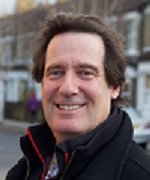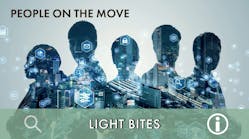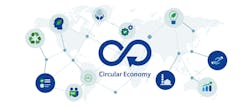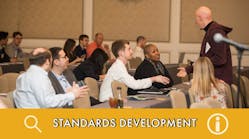European lighting regulations could help usher in human-centric lighting (MAGAZINE)
European regulators may have a play in delivering the Holy Grail of lighting for health and wellbeing. A simple directive or two mandating Internet connections may be all that it takes for now. MARK HALPER looks at the industry's 2017 EU regulatory priorities.
Look at the strategic 10-year roadmap for the European lighting industry, and the thing that stands out the most is the drive toward human-centric lighting (HCL) - the designing and tuning of LED light's biological, visual, and emotional effects to foster human health, wellbeing, and performance.
Interested in articles & announcements on human-centric lighting?
As charted by Brussels-based industry association LightingEurope, HCL will emerge as the top business force in a few years' time, and will continue to gain prominence after that (Fig. 1).
Human-centric lighting represents a big part of a necessary sea change in the lighting industry business model, and one that could help ensure a future for the 1000+ companies, 100,000+ jobs, and €20 billion of yearly revenue of LightingEurope member companies, including 33 manufacturers. Everyone knows that the century-old business model of selling replacement incandescent bulbs is falling apart now that LED lamps have become commonplace and are expected to last for a decade or three. In its place, says LightingEurope, bring on the HCL.
Learn more about human-centric lighting and how light promotes health and productivity at the 2017 Lighting for Health and Wellbeing conference July 27 in Newport Beach, CA:lightingforhealthandwellbeing.com
The general idea is that lights will adjust their on/off, brightness, colors, and color temperatures to levels that optimize any particular setting. A schoolroom, hospital ward, or open-plan office might emphasize blue hues during the morning to stimulate alertness; reds and oranges might take over in appropriate settings in the evening for a calming effect. Brightness levels might increase in a public place when more visually-challenged senior citizens than better-sighted teenagers are present. And so on.
FIG. 1. LightingEurope hopes that all regulatory routes, like its roadmap, lead to human-centric lighting.
As LEDs Magazine explored in a two-part series last summer and fall, HCL systems are already taking hold in hospitals and healthcare settings, and will slowly work their way into the workplace.
The benefits are potentially profound to people, business, and society: faster healing in hospitals; better educated and engaged kids; a more productive workforce; healthier, happier human beings (hence why you'll also see us refer to it as lighting for health and wellbeing).
So you might think that LightingEurope, which operates out of Europe's capital in large measure as a lobbying group to help shape lighting industry policy and regulations, is pushing hard and fast to mandate the adoption of HCL systems.
Not exactly. LightingEurope is angling to get regulators there alright. But it is taking a pragmatic approach, one regulatory step at a time.
With much of the science behind HCL still evolving and in need of further proof and case studies, the industry group is instead focusing on establishing regulations to implement the foundation technologies that could eventually support HCL.
Stepping stones
Consider, for a moment, that HCL aside, the industry is for other reasons already counting on selling the products, systems, and services that make it operational, and that support a profitable business model. As such, lighting infrastructure will morph into an information technology scheme. It will be full of sensors that detect things like human presence, motion, and natural light. Lights will connect both wirelessly and through Ethernet cable to phones, gadgets, and central control computers. The system will collect data to help it learn about and improve its own operations. The data will also hold tremendous value that could help run and inform other systems ranging from heating and cooling to marketing, sales, and promotions that might even be sold outside the company.
If that sounds familiar, it should. It's the same topology that is beginning to shape up in the myriad smart lighting schemes emerging today. Many of those fall short of true HCL. They might provide a rudimentary dose of the concept, supporting dimming or even changes in hue.
But for the most part, today's intelligent lighting schemes focus on energy savings and on data collection to help facilities managers make better use of their property and help retailers spot shopping trends and engage with customers.
With that in mind, LightingEurope is squarely engaged in two European Commission (EC) initiatives that could ultimately help establish IT systems as an integral aspect of lighting. Both concern themselves not with HCL per se but with energy savings.
One goes by the name of the Energy Performance Building Directive (EPBD). Specifically, the EC has proposed that the European Parliament amend the existing EPBD from 2010 so that it would require building owners to deploy "information and communications technology (ICT) and smart technologies" as a means to better control the energy consumption of building systems, and to include lighting.
The other initiative, called ENER Lot 37, is an EC study that examines the possibility of setting energy-efficiency requirements for lighting based on systems, rather than simply looking at the energy efficiency of a bulb. LightingEurope strongly encourages such an approach, and is furnishing the EC with ideas on how to accomplish it.
The IT mandate
From LightingEurope's perspective, the common thread between the EPBD and ENER Lot 37 is the potential to decree IT's role in lighting. That, in turn, sets the stage for full-on HCL a few years down the road.
"The opportunities that we have with the LEDification of the lighting business [are] that we are going from lamps that are made out of glass, and that function on certain physical and chemical rules, to a light source that functions on electronics," LightingEurope secretary general Diederik de Stoppelaar said in an interview with LEDs Magazine (Fig. 2). "And the electronics allow us to increase the scope of what we can do with lighting. There are simple examples, like we can change the color easily and, together with controls, we can do the most beautiful things with lighting and at the same time continue to save energy. We are moving up to intelligent lighting systems where of course the Internet of Things will play an important role. From there, with all the possibilities the Internet is offering, we will create human-centric lighting."
FIG. 2. LightingEurope secretary general Diederik de Stoppelaar says that lighting designers will play a key role in the HCL drive.
That may all be true. But the problem is that LEDs have become so well known for saving energy - the latest models require only about 10% of the energy that a conventional incandescent did - that people don't yet by-and-large think of them as information nodes and devices. It's akin to the early days of cellphones, when voice was the most common usage before people began to typically use them for web access, emails, and all manner of media and information. Smart LED lighting today has advanced to something equivalent to voice and text - but its heyday as part of a robust information upload and download habitat has yet to come.
"It requires a paradigm shift in our thinking, in the manufacturers' thinking, in the regulators' thinking, and even probably in the thinking of our customers," said LightingEurope president Jan Denneman, who is also an executive with Philips Lighting (Fig. 3).
To help move that thinking along in Brussels, LightingEurope is working with an EC group it knows well - the Directorate-General for Energy, which is one of 53 agencies and departments within the EC's executive branch, many of which are labeled as "Directorate-General" or "DG." LightingEurope is familiar with DG Energy because that is the directorate that has helped determine directives banning energy-hungry conventional lamps.
It is also the body that is considering amending the EPBD to require automated systems for controlling lighting and other building systems, a proposal that LightingEurope outright welcomes. In a position paper, LightingEurope pointed out that existing requirements have excluded lighting.
FIG. 3. LightingEurope president Jan Denneman calls for a "paradigm shift in thinking" from everyone, including manufacturers, regulators, and users. (Source: Mark Halper.)
"LightingEurope is glad to see that the European Commission proposal imposes on Member States to set system requirements for all the technical building systems, built-in lighting included," LightingEurope said in a public statement on the proposed amendment last December. "This is because the share of lighting in the final energy consumption of non-residential buildings reaches up to 30%. A proper implementation of lighting systems strongly reduces the final energy consumption of lighting. Requirements for new and renovated buildings should include replacement of conventional lighting with LEDs. Together with lighting controls and daylight and occupancy sensors, this will result in around 60% energy savings."
LightingEurope plans to provide recommendations to DG Energy this year, and hopes for the proposed amendment to become a directive in the first half of 2018. In European Union speak, a directive is a legally binding result that member countries must achieve, although there is latitude in how each country achieves it.
It's the system, stupid
It is DG Energy, again, that has initiated the ENER Lot 37 study examining the possibility of defining lighting's energy use by looking at lighting systems, not just at light sources. While the study is not currently tied to any actual or proposed directive, LightingEurope notes that it well could eventually apply to the EPDB or to other directives.
It heartily embraces the idea. As de Stoppelaar noted, in the long run, the efficiency of the lighting system ties into lighting design, which in turn leads to the ultimate objective of lighting that impacts health and wellbeing.
"If you want to improve the quality of lighting, you need to talk to the people who are influencing the lighting, and a very important group is the lighting designers," he said. "So we are trying to work out together with the commission some systems, some position papers, to set certain requirements. And we are working also together with the lighting designer community to have them involved, so when they are designing in buildings they keep in mind that it's the human they should center on. We are talking with DG Energy, because the DG Energy sets regulations for lighting design, and we work closely with them. And we try to make clear to them that energy saving, energy efficiency should not be the only aspect of lighting design. There is more to lighting design."
Denneman added, "We hope the study [Lot 37] can become the coat hanger of system-level requirements on lighting in buildings.
"Our main message to DG Energy is that we do not want to continue to focus on product efficiencies, but much more on system-level requirements. We believe that our lighting products are already efficient enough, and that if the commission wants to get additional energy savings, that it should be focusing on system requirements. Ultimately what we want is that we get away from requirements on installed power for example, on lighting in buildings, and move to usage rules for energy. It requires much more intelligence, sensors, software to realize that."
Intelligence, sensors, and software: That's a big part of the recipe for human-centric lighting, too. That's no coincidence.
Other fish to fry, people to meet
As the lighting industry morphs into more of an information technology industry, and one that promotes health and wellbeing, it will behoove it to broaden its lobbying reach within the Brussels bubble.
Much of the liaising between industry association LightingEurope and the European Commission has over the years involved the EC's energy group, called the Directorate-General for Energy (DG Energy). That relationship stems from what has been the seminal selling point of LED lighting - energy savings.
LightingEurope will continue to work with DG Energy. Among other reasons, as our main piece points out, the information technologies that will support more advances in energy efficiency are the same technologies that will buoy HCL. Establishing them through an energy framework marks a good starting point.
But as the industry shifts its energy-savings approach to more of a systems level as opposed to a product one, and as it takes on the broader remit of human-centric lighting, it will need to walk through doors at other directorates, such as IT-focused DG Connect, and directorates for education (schools could use a good shot of HCL), the environment, economic growth, and also with the health and food safety directorate, called DG SANTE.
It's working on it.
"Absolutely," secretary general Diederik de Stoppelaar told LEDs Magazine. "We have started talking and we already for some time have been talking of course with the DG Connect on the connectability of our products. We are talking with DG Grow [the name of the EC's industry and entrepreneurship group] on how can we create opportunities to assure growth of the lighting business in Europe, and in this way assuring that manufacturing, research, and development will stay in Europe. We are talking to the DG Environment because of course there are always environmental opportunities that need to be dealt with. The circular economy is one of them - how can we think of having lighting systems that are serviceable or repairable or maintainable or reusable?"
LightingEurope does indeed seem to be getting around Brussels more, based on a video on its website regarding the launch of its HCL working group.
As chairperson of LightingEurope's new HCL working group, Annette Steinbusch is making a point of approaching a wider set of directorates including the health and food safety group, known as SANTE. Healthy buildings are on her agenda. And she wants the EC to lead by example and deploy HCL in its own buildings.
"We will take advocacy to the DGs in Europe," said Annette Steinbusch (shown), chairperson of the working group, in the video. "So, Energy, Growth, and also SANTE are on our list." The SANTE connection might square with what Steinbusch said will be a "healthy buildings" drive by LightingEurope. "We think healthy buildings is one of the top activities where we should try to get human-centric lighting included," Steinbusch said.
She also noted that LightingEurope is approaching the OIB (Office for Infrastructure and Logistics in Brussels) - an EC group that looks after the EC's own buildings and infrastructure.
"All the European buildings should lead by example, so we would like to have human-centric lighting in those buildings from the European Union," she said.
LightingEurope hopes to establish a "framework for regulations" that stitches these various fronts together, Steinbusch noted, adding that "we want to check into all the ongoing projects, policies, and consultations where we can find a regulatory hook to get some kind of human-centric lighting regulation included."
Meanwhile, LightingEurope will continue to engage in more near-term regulatory matters. For example, the EC is working out a new Single Lighting Regulation that would simplify three different pieces of energy regulations for lighting into one. LightingEurope agrees with the overall objective, but currently disagrees with some of the proposed specific changes. LightingEurope is also weighing in on proposals to revise an existing voluntary instrument called the Green Public Procurement on Street Lighting.
The year 2017 is shaping up as a very busy one for the advocacy group, both on new frontiers and on established ground.
MARK HALPER is a contributing editor for LEDs Magazine, and an energy, technology, and business journalist ([email protected]).
*Updated Mar. 17, 2017 8:20pm for photo credit.

Mark Halper | Contributing Editor, LEDs Magazine, and Business/Energy/Technology Journalist
Mark Halper is a freelance business, technology, and science journalist who covers everything from media moguls to subatomic particles. Halper has written from locations around the world for TIME Magazine, Fortune, Forbes, the New York Times, the Financial Times, the Guardian, CBS, Wired, and many others. A US citizen living in Britain, he cut his journalism teeth cutting and pasting copy for an English-language daily newspaper in Mexico City. Halper has a BA in history from Cornell University.








